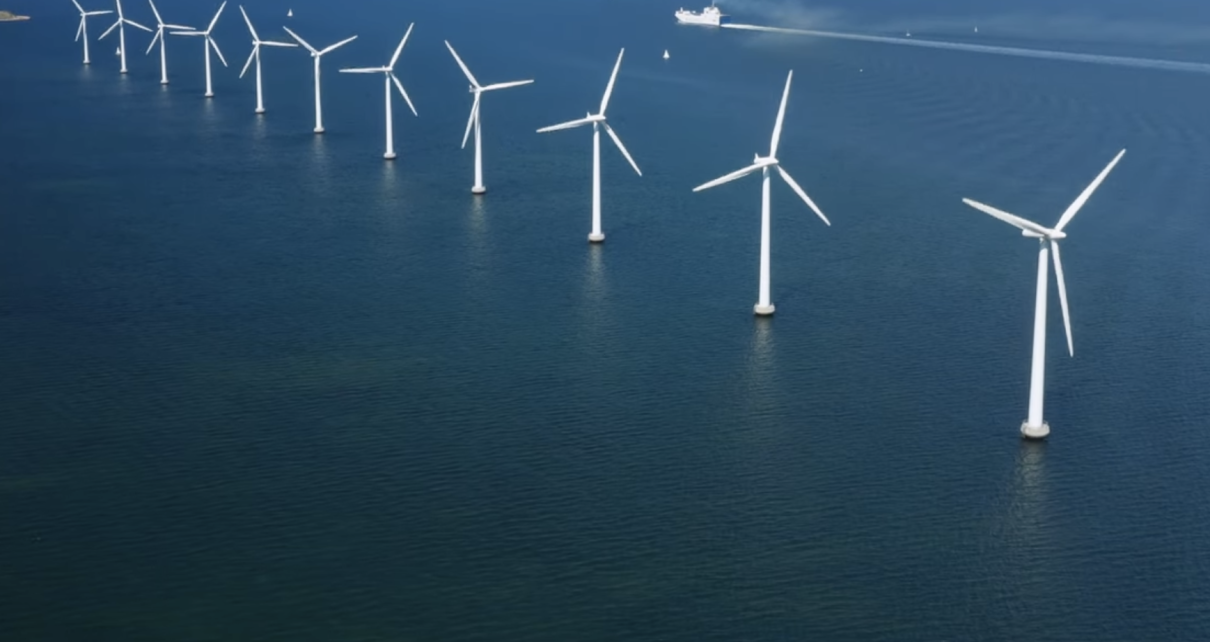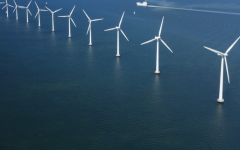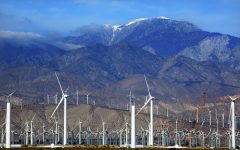
Offshore Wind farm. (Photo: Energy.ca.gov)
Ringside: Floating Offshore Wind – A Financial Catastrophe
Offshore wind is a terrible idea, but the California Energy Commission pushes forward
By Edward Ring, August 15, 2024 2:08 pm
 When it comes to looming financial and environmental catastrophes, nothing can compare to floating offshore wind. It is energy policy at its worst.
When it comes to looming financial and environmental catastrophes, nothing can compare to floating offshore wind. It is energy policy at its worst.
In an analysis earlier this year (WC #36), using cost estimates published by a European energy consulting firm, I estimated the total project cost for floating offshore wind off the California coast at, best case, $13.6 million per megawatt of baseload-equivalent capacity. “Capacity” is an often misunderstood word. The “nameplate capacity” of a wind turbine might be 10 megawatts, but that amount of electricity is only going to be generated when the wind is blowing and the system isn’t down for maintenance. With intermittent sources of electricity generating technologies such as wind turbines, the “yield” is what matters, and that is unlikely to ever exceed 40 percent, even offshore.
Taking into account intermittency, the U.S. Energy Information Administration estimates a construction cost of $10 million per megawatt. But that estimate is for the less expensive “fixed bottom offshore wind with monopile foundations,” and not for floating platforms. As economist Jonathan Lesser, author of “The False Promises of Offshore Wind,” shared with me via email last week, “the technology for the cabling needed to secure the turbines to the floor and the cables to carry the electricity are in their infancy. I conclude that the EIA estimate for floating turbines is, in my view, pure fantasy.” Which is to say, more than $10 million per megawatt.
Another expert I was fortunate enough to reach is Gordon Hughes, a professor of economics at the University of Edinburgh. For the last several years he has been analyzing the performance of offshore wind in the North Sea and throughout the world. Here’s what he wrote to me in a recent email:
“I don’t believe the figures given by EIA – they have no basis in actual costs and performance, they are little more than optimistic guesses generated by lobbyists. No-one knows how to build floating wind turbines with a tip height of 220 or 250 meters. The rotational forces in high winds are huge and the only way to stabilize them are to build huge concrete/steel platforms. I have no idea where they would be built on the West Coast and I doubt that towing them across the Pacific from East Asia is viable. Could they transit the Panama Canal? The point is all talk of floating wind farms off California or Oregon seems to me to be ungrounded speculation. You could build ones with a tip height of 150 meters but that would significantly reduce both the nominal capacity and capacity factor for such turbines.”
At that height, still nearly 500 feet, nameplate capacity is only 2.5 megawatts per turbine. We would have to float 10,000 of these monstrosities in order to achieve the currently planned 25 gigawatt capacity off our coast.
As acknowledged in a Cal Matters report from July 2024, “The offshore wind industry must be created almost from scratch: a new manufacturing base for the still-evolving technology; a robust and reliable supply chain; transportation networks on land and sea; specially configured ports to make, assemble and maintain the gargantuan seagoing platforms; finding and training a highly specialized workforce; building a large transmission network where none exists and beefing up those that operate now.”
Compare that to the EIA’s estimates to construct other types of electricity generating plants. A natural gas fueled electricity generating plant with 95 percent carbon capture will only cost $2.4 million per megawatt. Advanced nuclear: $7.8 million per megawatt. Small modular nuclear: $8.9 million per megawatt. Geothermal: $3.9 million per megawatt.
Imagine the scene if this abominable scheme ever comes to full fruition. To produce 25 gigawatts of capacity would require at least 2,500 wind turbines floating approximately 20 miles offshore. To have a capacity per turbine of 10 megawatts, each of them would be approximately 1,000 feet high, and each of them would have at least three tethering cables hooked to the sea floor over 4,000 feet underwater. Each of them would also need an underwater high voltage cable that would somehow connect to the onshore grid.
Offshore wind is a terrible idea. There are plenty of alternatives, including the only slightly less unpalatable option of onshore wind. But the California Energy Commission pushes forward. The rhetorical bludgeon used to silence critics and empower the special interests poised to make a killing is predictable enough. From Cal Matters, here’s a quote from one of the CEC’s five commissioners. “‘I feel the urgency to move forward swiftly,’ said energy commissioner Patty Monahan. ‘The climate crisis is upon us. Offshore wind is a real opportunity for us to move forward with clean energy.’”
Clean energy does not have to require hundreds of billions in taxpayer subsidies and utility rate increases. Clean energy should not rely on technology that isn’t ready and components that can’t be sourced. And clean energy shouldn’t destroy the environment. Invoking the “urgency” of climate change without addressing the issues of cost, technology, materials, and environmental impact, is a vapid and irresponsible but all too common tactic.
Let’s assume that we industrialize some of the most pristine stretches of the California coast and foul our offshore waters with between 2,500 and 10,000 floating wind turbines. We will have 25 gigawatts of new capacity, yielding 10 gigawatts of steady power once sufficient land-based storage assets are available. That equates to 87,600 gigawatt-hours. Even at $10 million per megawatt, which is a best case estimate, the total project cost will be $100 billion. To generate the same amount of power capacity by constructing new, advanced combined cycle natural gas generating plants with sequestration of CO2 emissions would cost $25 billion. That’s four times less expensive.
Next week we will review the environmental impact of floating offshore wind.
- Ringside: Will the Delta Pumps Operate at Capacity this Winter? - December 18, 2025
- Ringside: Will Advocates for More Water Supply Projects Find Unity? - December 11, 2025
- Ringside: EVs and California’s Future Demand for Electricity - December 4, 2025




As always Follow The Money! I would bet that the urgency has to do with certain financial incentives that are never disclosed from the people who profit from the sales and installations. The electricity consumers are screwed with confiscatory electric rates while those who sell these monstrosities laugh all the way to the bank. Then there are the millions of sea birds these will kill each year and the (probable) hundreds of whales. Funny how the enviros never utter a peep about this.
I hope these are all installed right off the Malibu coast.
This is my pet peeve these days…. These bogus wind and battery farms. They are the most blatant rip-off I have ever seen. The last big money transfer involves using the public tax and rate payers to enrich the few who are using the government front men and woman to sell it .
I’m hoping this is the hill these officials fail on. Getting caught not serving the people but the elites.
Hi Ed,
Great article. I suspect that like the High Speed Rail project, offshore wind (and Lithium Valley) is more about funneling money into union-based construction projects and social justice set-asides than solving an actual problem. Give that assumption, costs are less relevant and performance is completely irrelevant.